If you’re dreaming of a tranquil escape in the UK, wild camping in the Lake District National Park might just be your next grand adventure. The stunning surrounding fells and the calm of the spectacular lakes offer a getaway where you can immerse yourself in nature, leaving the bustling tourist villages behind.
In this guide, I share some of my favourite wild camping spots in the Lake District, discuss the legalities of wild camping, and provide some valuable tips to help you get the most out of your next wild camping adventure.
If you’re new to wild camping, or even an experienced wild camper, check out my Complete Wild Camping Guide here. It’s packed full of tips, gear recommendations and advice on best practices to help you navigate your wild camping trips in the great outdoors with confidence and ease. There’s something for everyone!
This article contains affiliate links. If you buy through them, I may earn a commission at no extra cost to you. Learn more here
Is It Legal to Wild Camp in the Lake District?

Before we delve into the list of wild camping spots in the Lake District, it’s vital to address the legal intricacies surrounding wild camping in this renowned region.
In the UK’s Lake District, wild camping isn’t strictly illegal, but it isn’t generally tolerated without the landowner’s permission, especially in certain higher areas as long as campers follow specific guidelines. For the most detailed and current information on wild camping rules in the Lake District, check out the Lake District National Park Authority.
Should you encounter any issues with a landowner while camping, always remain calm and polite, pack up promptly, and relocate. Adhering to the Leave No Trace principles is essential – the pillars of wild camping. These principles encompass arriving discreetly, departing early, and ensuring no trace of your stay remains. Upon your exit, the scenic beauty of the Lake District should remain undisturbed, as though your visit never occurred.
Choosing the Perfect Spot for Wild Camping in the Lake District
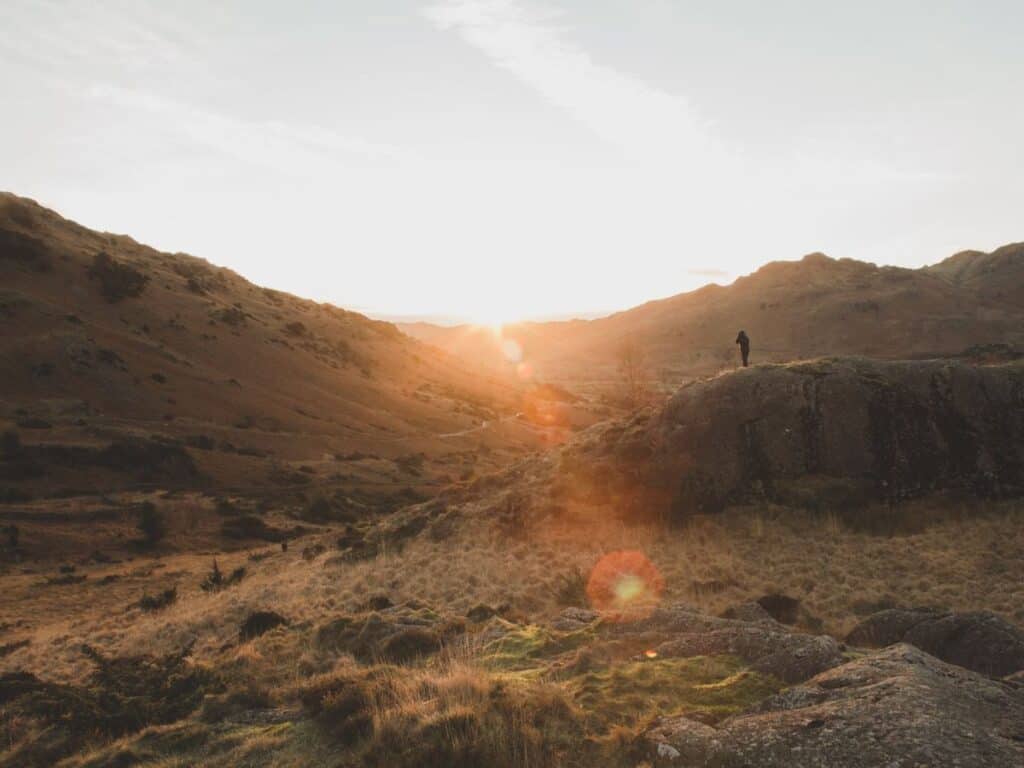
Selecting the right location for wild camping in the Lake District can make all the difference to your experience so if you are planning your first wild camp you’ll want to pay attention. While the region boasts a wealth of picturesque landscapes, not all spots are equally suitable for camping. Here’s a guide to help you pinpoint that dream location in the Lake District:
Elevation Matters: Aim for higher ground, away from the busy paths and popular tourist spots. Not only does this offer more seclusion, but it’s also where wild camping is generally more tolerated.
Distance from Water: While camping near a serene tarn might sound idyllic, remember to set up camp at least 50 meters away from any water sources to protect fragile ecosystems and avoid disturbing wildlife.
Safety First: Look for a flat piece of ground, free of large rocks and roots. Ensure you’re not too close to cliff edges, especially if you plan to set up camp in the dark or in conditions with limited visibility.
Accessibility: Choose a location you can safely and reasonably access. If you’ve had a long day of trekking, consider how much energy and daylight you have left before deciding to pitch.
Respect the Land: Always keep in mind the land’s ownership. If you’re on private land, it’s best to seek permission. On open common lands, be more discreet, adhering to the Leave No Trace principles.
Weather Watch: The Lake District weather can be quite changeable. It’s always wise to check the forecast before you set off and be prepared for all conditions. Remember, what seems like a calm spot in the afternoon can become quite exposed if the weather shifts.
Plan B: It’s always smart to have an alternative location in mind. Whether it’s due to unexpected foot traffic, landowner concerns, or unsuitable terrain, being flexible can save you a lot of stress.
In essence, the Lake District’s charm lies in its wild, untouched beauty. When selecting your wild camping spot, always remember to prioritize safety, respect for the land, and the well-being of the region’s natural habitats.
Now let’s jump into my top 10 wild camping spots in the Lake District.
Top 10 Wild Camping Spots in The Lake District
The Lake District boasts diverse landscapes perfect for wild camping. From its prominent fells to serene tarns, every area offers a unique experience. But where to pitch your tent?
In this section, we’ll explore 10 standout Lake District wild camping locations.
Sprinkling Tarn, Rosthwaite
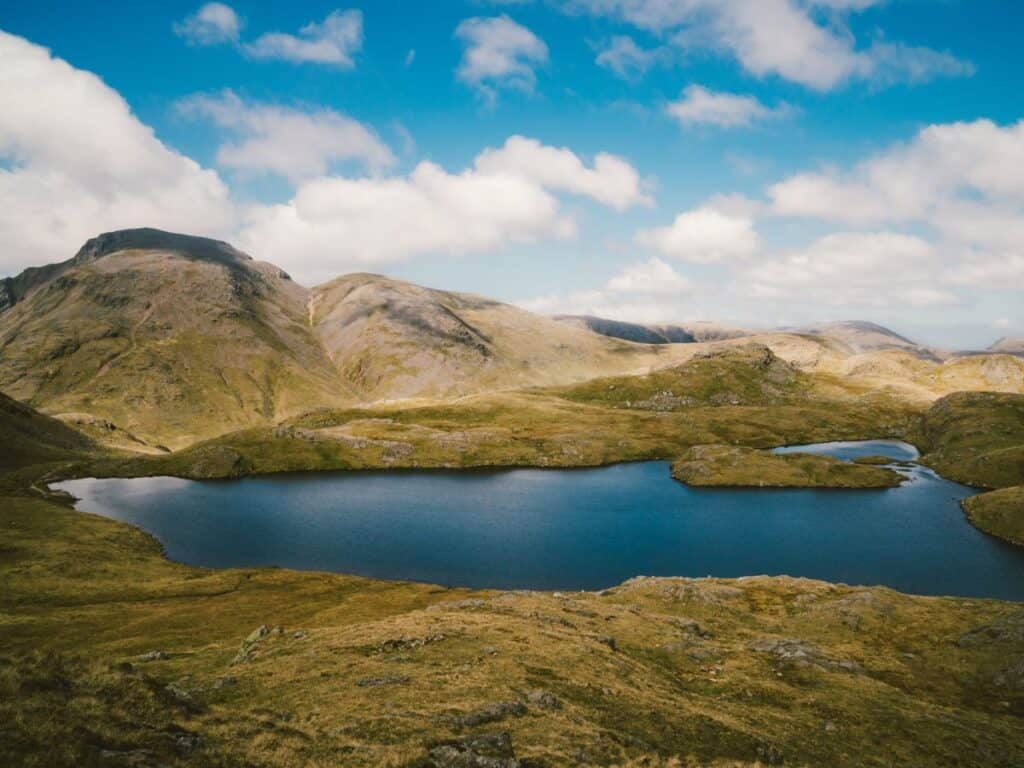
Nestled between the towering fells of Seathwaite and Styhead, Sprinkling Tarn is a wild camper’s dream. Ensure you have the right wild camping equipment to fully enjoy this spot, as the weather can change rapidly. While it remains one of the Lake District’s hidden treasures, those who make the trek are rewarded with sweeping views of surrounding peaks, including the majestic Great End and Allen Crags.
As you make your way towards the Tarn, the journey unfolds like a classic Lake District tableau. The Borrowdale Valley stretches out, a beautiful mosaic of grassy hills, jagged rock formations, and tranquil brooks. Upon arrival, you’re presented with diverse options for pitching your tent. Opt for a cosy spot by the water’s edge, or perhaps ascend slightly higher, capturing the perfect vantage point for sunrise.
Though Sprinkling Tarn offers a peaceful retreat, it’s not entirely off the beaten path. Hikers embarking on the Scafell Pike or Glaramara trails often use it as a waypoint, creating moments for shared appreciation of the landscape. But as daylight wanes, the area reclaims its serenity, providing campers with a quiet evening beneath a star-studded sky.
For those seeking a genuine wild camping experience—one that effortlessly melds accessibility with the feeling of seclusion—Sprinkling Tarn in Rosthwaite stands out as a must-visit.
Codale Tarn, Grasmere
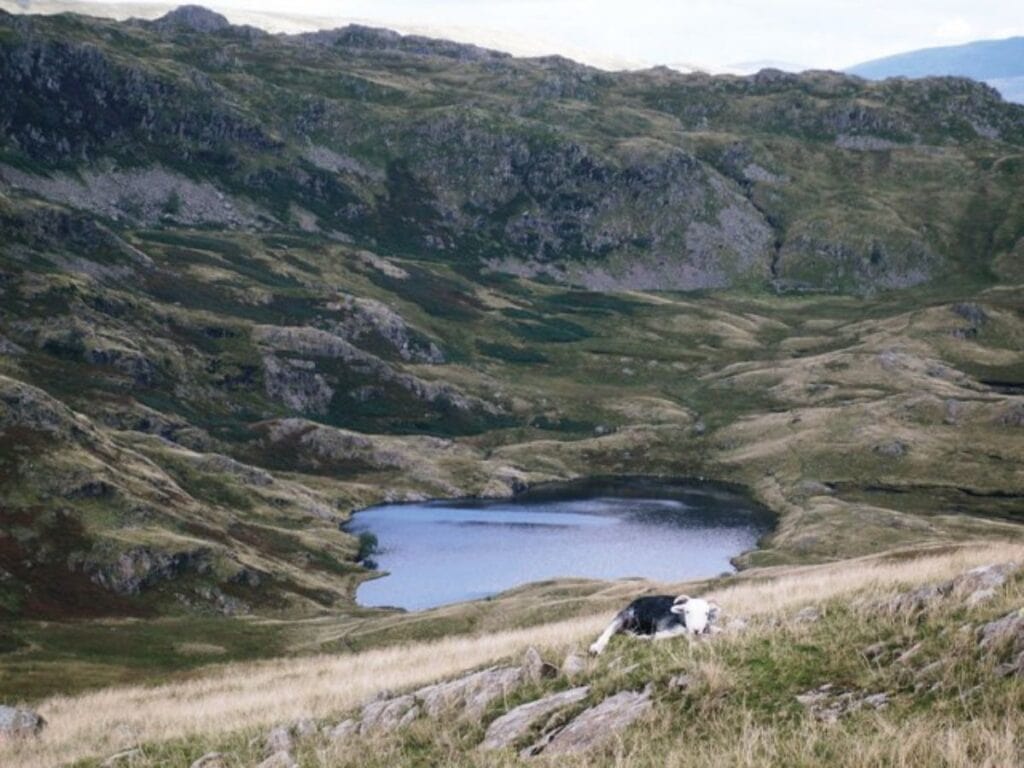
Tucked away from the well-trodden paths, Codale Tarn is a gem for wild campers in search of serenity. Nestled near Grasmere, this modest-sized tarn offers a sense of solitude despite its proximity to more popular destinations such as Easedale Tarn to the East.
Starting your trek to Codale Tarn, you’ll encounter diverse terrains ranging and bubbling brooks, with periodic glimpses of Helm Crag providing a majestic backdrop. As you approach the tarn, you’re greeted with a calm, reflective water surface that, on clear days and nights, captures the sky’s ever-changing mood.
Its secluded nature ensures a peaceful wild camping experience. The area surrounding the tarn provides a sheltered space and ample opportunities to set up camp, with the western elevated grounds offering a particularly striking view of the water and beyond.
Codale Tarn’s charm lies in its balance: easily accessible, yet it feels a world away from the hustle and bustle. It’s a haven where wild campers can truly connect with the Lake District’s untouched beauty.
Lingmoor Fell, Ambleside
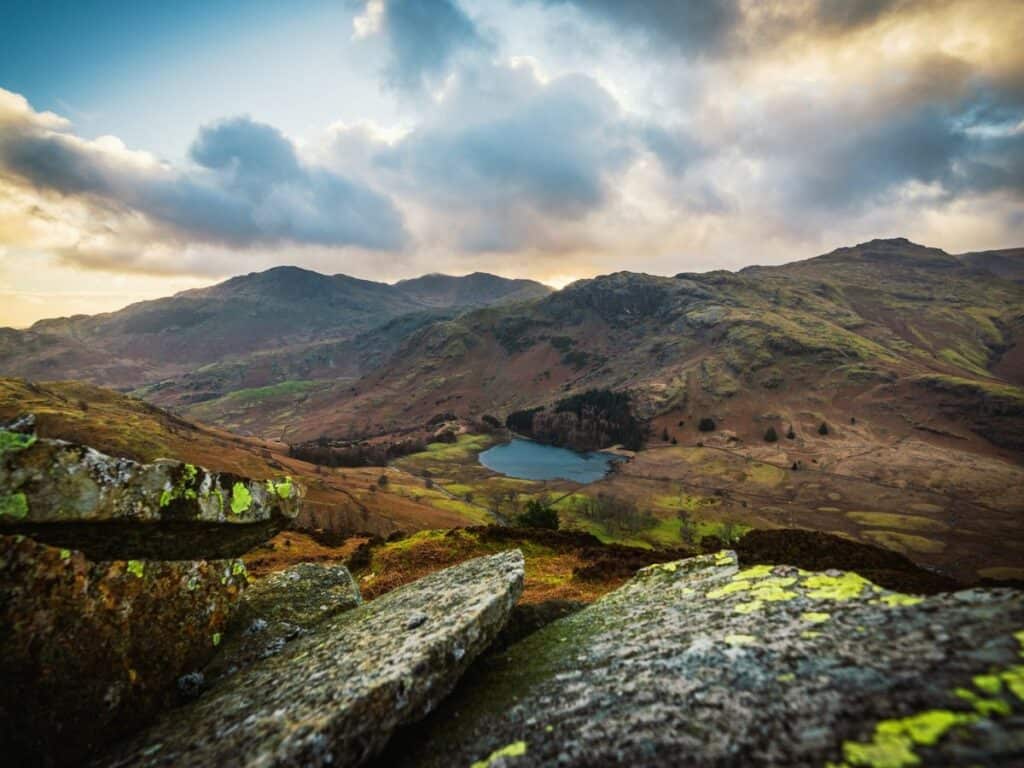
Lingmoor Fell is a beacon of tranquillity that promises wild campers sweeping vistas of the central fells and the elongated sprawl of Windermere. Situated near Ambleside, this elevated vantage point offers panoramic views that are hard to rival.
The journey to the summit is as rewarding as the destination itself. As you make your ascent, the patchwork of the Lake District unfolds beneath you, with the spectacular Lake Windermere revealing itself in all its glory.
One of the highlights of camping on Lingmoor Fell is the dawn view. Pack a quality wild camping sleeping bag to ensure a warm sleep before waking up to this breathtaking sight. As the sun peeks over the horizon, it casts a warm glow over the valleys below and illuminates the nearby fells, creating a spectacle that’s well worth the early rise.
The fell offers a range of terrains for setting up camp, but the area near Side Pike is particularly favoured for its unobstructed views. Here, the sky stretches out in an endless canopy, perfect for stargazing.
After your night on Lingmoor Fell, consider a morning detour to Cathedral Cave near Little Langdale. Trust me, it’s a hidden gem that you won’t want to miss. If you drive to the cave, don’t make the same mistake I did. Park in the car park just North of the village and do not try and cross the Ford in search of closer parking. There is none and you may get stuck.
Holme Fell, Coniston
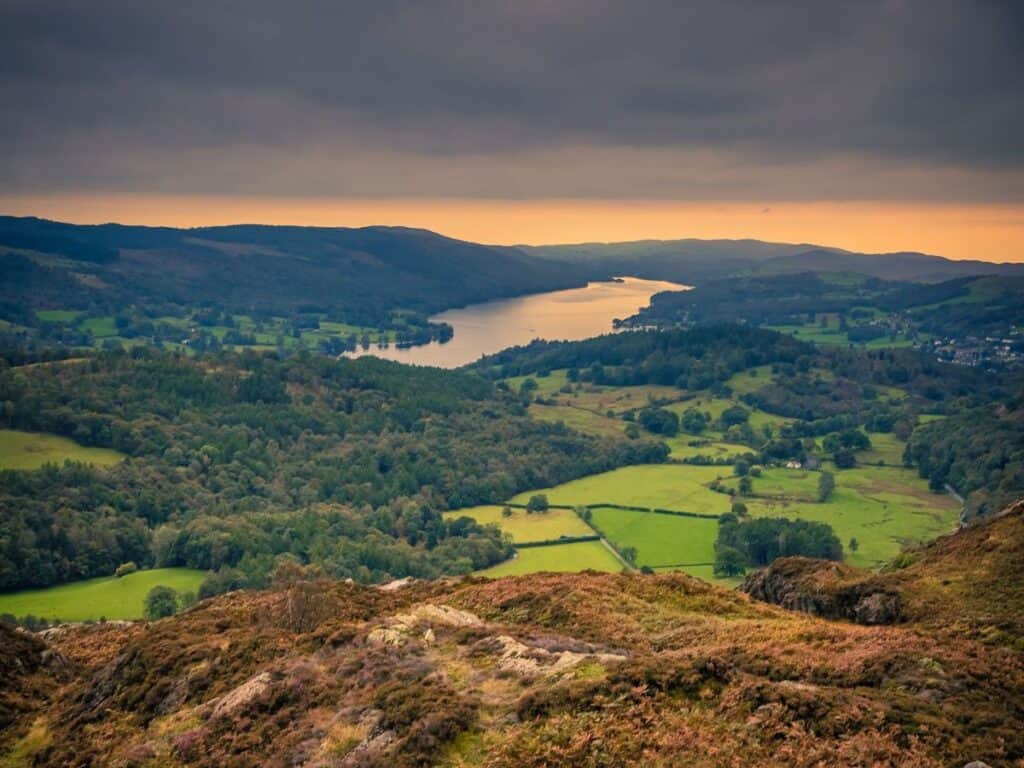
Located just a stone’s throw away from the quaint village of Coniston, Holme Fell is a gem waiting to be discovered. While it might not have the soaring peaks of some of its neighbours, what it lacks in height, it more than makes up for in charm and solitude.
The vantage point from Holme Fell unveils a sprawling view of Coniston Water. By day, the sun dances on the water’s surface, creating a sparkling spectacle. As the day fades, the horizon often paints a dramatic scene, with golden hues casting long shadows across the landscape, making it a perfect spot for photographers or simply those who appreciate the beauty of nature.
Historically, the area was a hive of quarrying activity, and remnants of this past can still be observed today. These ancient quarries add a touch of character and a sense of timelessness to the locale. The moss-covered stones and quiet trails tell stories of times gone by.
Though Holme Fell is relatively less frequented, its tranquillity is its prime asset. It offers a respite from the bustling tourist hubs, granting wild campers a unique blend of peace and raw natural beauty.
Nearby, the village of Coniston beckons with its rich history. It’s a place where one can wander through cobbled streets, delve into local folklore, and enjoy a cup of tea or a hearty meal after a night spent amidst the fells.
Haystacks (Innominate Tarn), Cockermouth
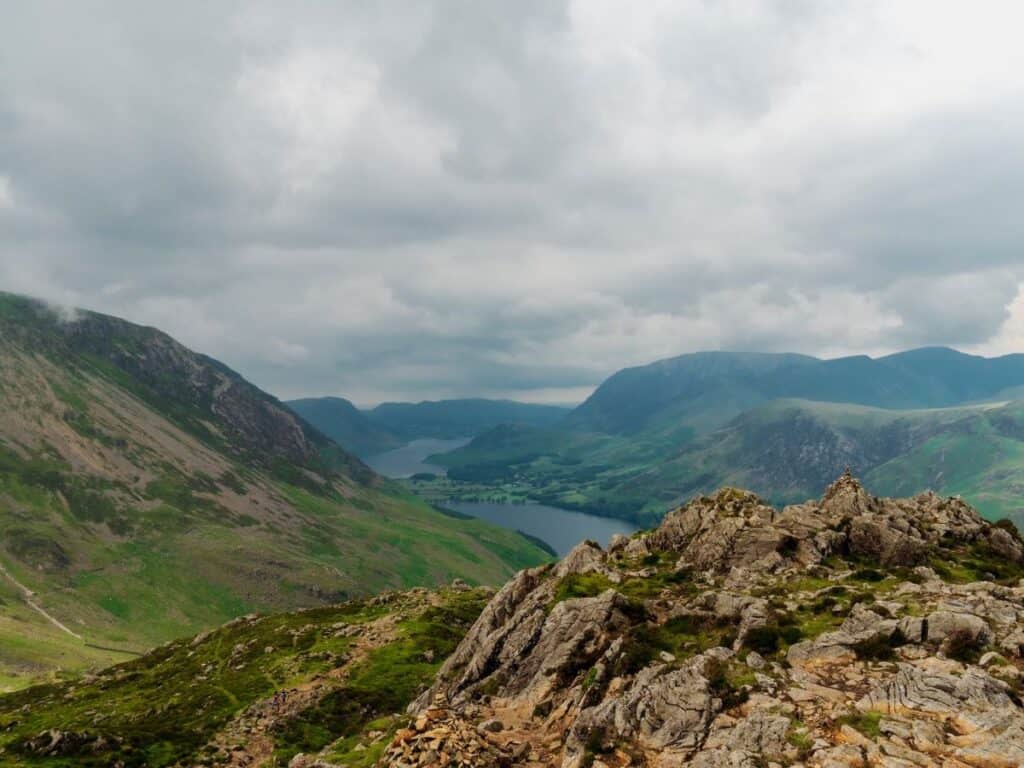
Situated in the north of the Lake District National Park, Innominate Tarn, a name derived from the Latin term meaning “without a name”, is a tranquil water body nestled near the summit of Haystacks.
Haystacks itself is an exemplar of the diverse terrain The Lake District has to offer. With a myriad of landscapes that change as you ascend, it’s a wild camper’s delight. The tarn, with its calm waters, contrasts starkly against the rough textures of the fells and crags encircling it.
Given its unparalleled beauty and tranquillity, it’s no wonder the renowned guidebook author Alfred Wainwright held Haystacks in such high esteem, declaring it his favourite fell and choosing it as his final resting place.
The trek up to the tarn itself is a rewarding one. While it presents moderate challenges, the changing landscapes, from lush green meadows to rocky paths, ensure there’s no room for monotony.
Its close proximity to Cockermouth means wild campers have the added advantage of exploring the birthplace of the celebrated poet William Wordsworth, diving deep into the rich literary legacy of the region. All in all, Haystacks and Innominate Tarn provide a holistic experience, blending nature, history, and literature in a seamless tapestry.
Ennerdale Valley, Ennerdale
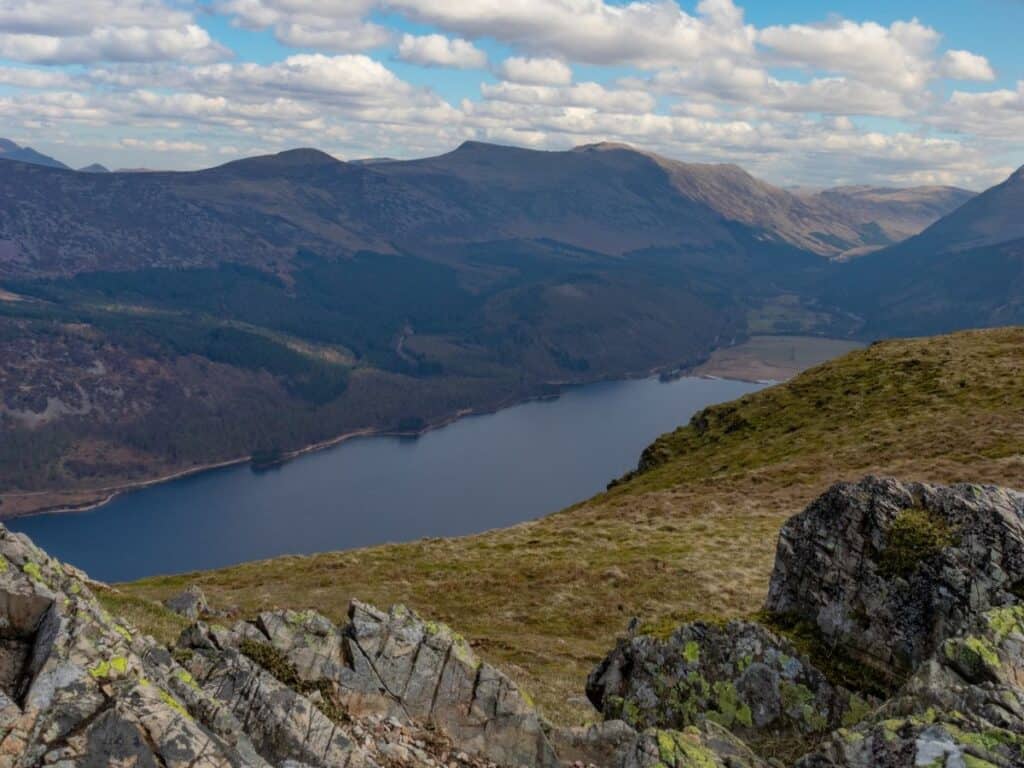
Ennerdale is a world away from the bustling tourist spots in the Lakes, and it’s the untouched rawness of the Ennerdale Valley that draws wild campers in. Unlike its more frequented neighbours, Ennerdale has managed to retain a secluded atmosphere that seems a tad otherworldly.
The valley stretches out beneath a canopy of one of England’s oldest and largest forests, with whispering pines and ancient oaks that tell tales as old as time. The River Liza snakes through, its clear waters shimmering in the dappled sunlight, shaping the land with each gentle curve and turn.
But the pièce de résistance? The dark, vast expanse of Ennerdale Water. It’s the most westerly lake of the lakes, and perhaps the most mysterious. Here, there’s no boating, no buildings interrupting the shoreline, just endless peace and pure undisturbed nature.
For those seeking solitude and a genuine connection with nature, this is it. At night, the lack of light pollution grants you a celestial show; stars pepper the sky, the Milky Way stretches across, and if you’re lucky, a shooting star or two.
This isn’t just a wild camping spot; it’s an escape, a retreat. Ennerdale offers a kind of serenity and simplicity that’s becoming harder and harder to find. Whether you’re lying by the lakeside or hiking up its fells, the valley promises an immersive experience, one that lingers long after you’ve packed up and left.
Angle Tarn, Patterdale
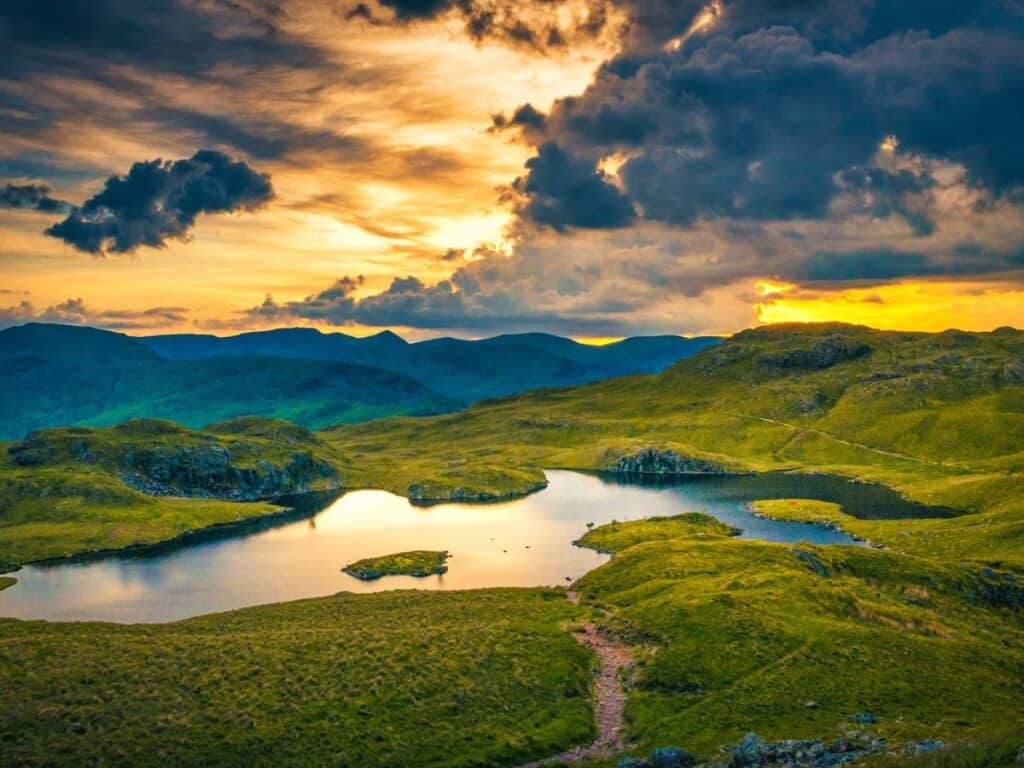
When it comes to iconic wild camping sites in the Lake District, Angle Tarn easily ranks high on the list. Set against the magnificent backdrop of surrounding fells, its allure is undeniable. The tarn itself is a spectacle – a perfect location to sit and take in the shifting hues of both sunrise and sunset.
Its accessibility plays a part in its popularity with outdoor enthusiasts. Starting from the Patterdale car park, the path to Angle Tarn is straightforward, making it a preferred choice for both seasoned campers and those new to wild camping. As you make your way up, every step rewards you with increasingly breathtaking panoramas of the Lakes.
However, the very features that make Angle Tarn so desirable also mean that it can get quite busy, especially during the warmer months and weekends. The chance of sharing this natural haven with fellow wild campers is high. But don’t let that deter you.
Angle Tarn is an experience, a place where memories are forged under the vast Cumbrian skies. Whether you’re seeking solitude, photography opportunities, or simply a night under the stars, this location promises a rich and unforgettable adventure.
Fleetwith Pike, Cockermouth
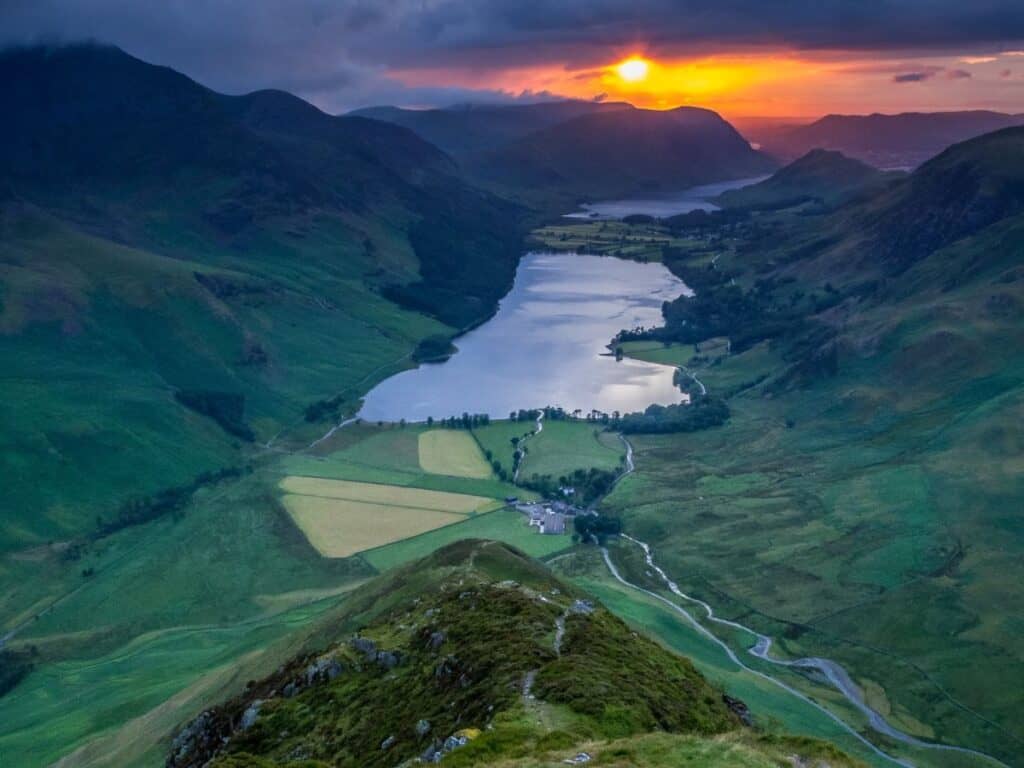
Fleetwith Pike, towering at 648 metres, is more than just a dramatic peak in the Lake District. It offers an enthralling wild camping experience for those willing to take on its challenge. Situated on the western end of Buttermere Valley, the ascent to its summit rewards with sweeping vistas of Buttermere Lake and Crummock Water.
The location is iconic not just for its panoramic views but also for the sense of adventure it provides. The route up via Fleetwith Edge is steep and exhilarating, making it an attractive option for those seeking a bit of thrill along with their camping trip. Once at the top, the expansive flat areas make for good pitching ground, allowing campers to set up their tent with a front-row seat to some of the most awe-inspiring sunrises and sunsets the Lakes have to offer.
It’s worth noting that Fleetwith Pike’s altitude means it can be quite breezy, even during the summer months. As such, a sturdy tent and pegs are recommended. And while the ascent might be challenging for some, the tranquil ambience, coupled with the unmatched views, makes every step worth it.
Raven Crag, Thirlmere
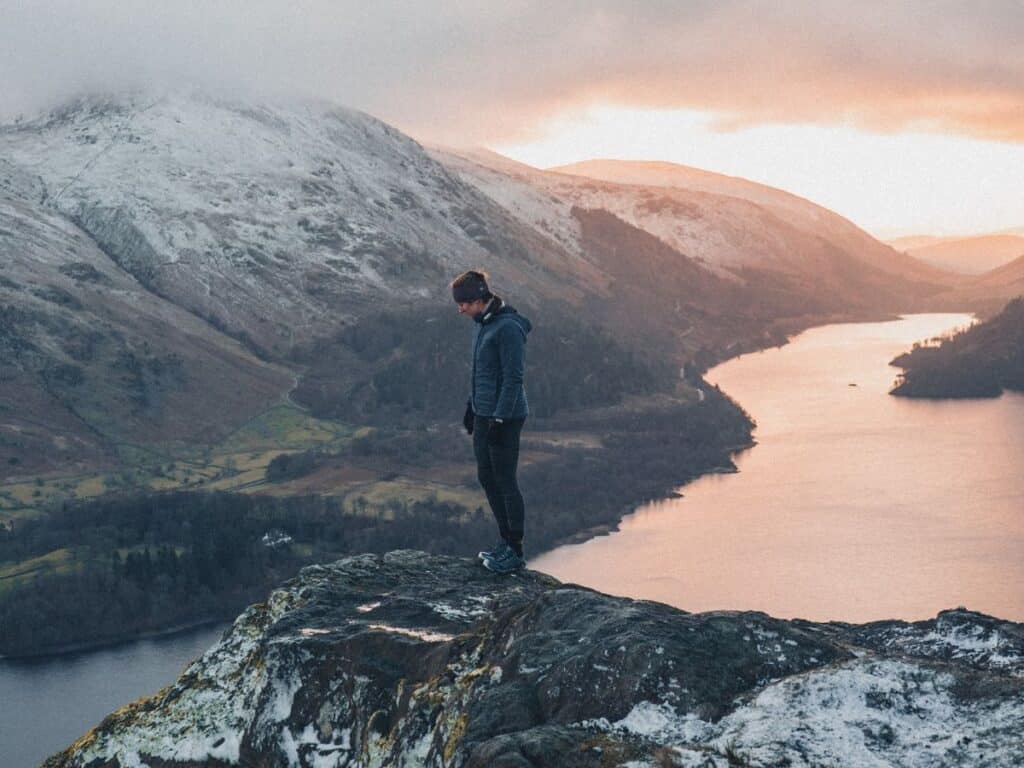
Raven Crag is a dramatic, imposing crag that rises boldly from the eastern shores of Thirlmere. It’s a sanctuary for wild campers seeking a blend of seclusion and splendour, nestled within the Lake District’s vast expanse.
Renowned for its formidable vertical rock face, which is a magnet for climbers, the crag itself holds another treasure: a vantage point that offers breathtaking views over Thirlmere, with Helvellyn and Skiddaw ranges painting the distant horizon. Camping atop this crag means you’ll be greeted by these panoramic views first thing in the morning and be treated to a celestial display of stars come nightfall.
Reaching the summit is reasonably straightforward from the small car park near Thirlmere. The ascent, taking you through a mix of woodland and open fell, is steep but short, making it accessible even for those new to hiking. Once at the top, the plateau offers a scattering of flat areas, perfect for pitching a tent and settling in for a memorable night under the stars.
Given its accessibility and unparalleled vistas, Raven Crag is an idyllic spot for both first-time wild campers and seasoned adventurers. A night spent here is a night surrounded by the essence of what makes the Lake District so unforgettable.
Red Tarn, Patterdale
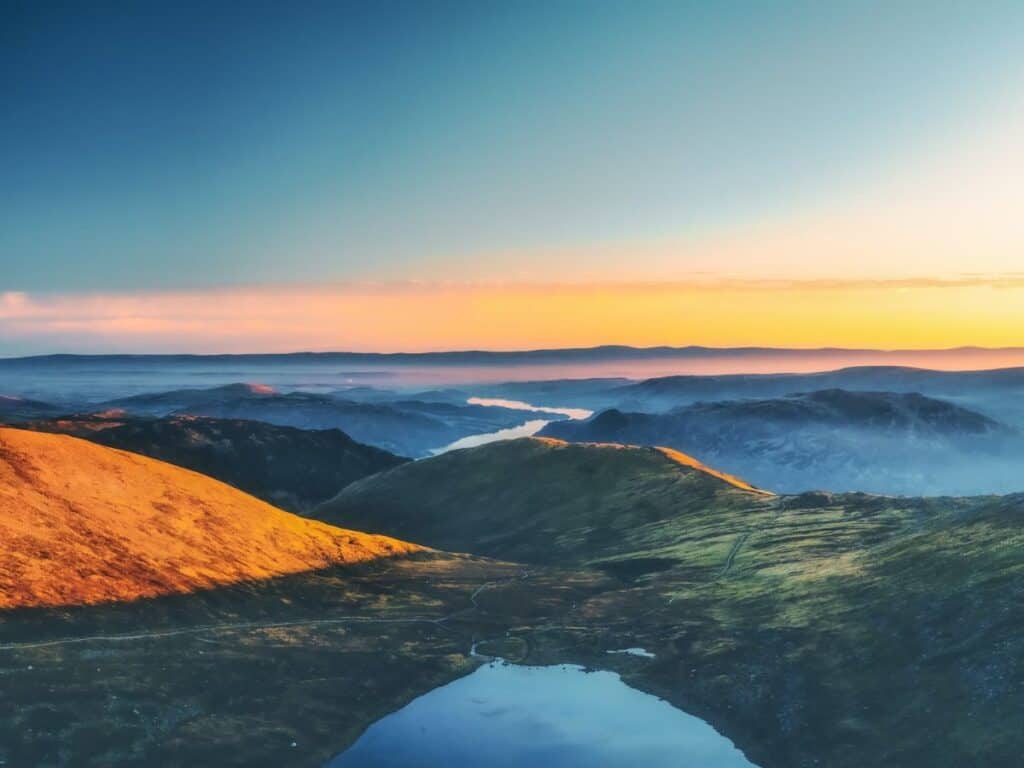
Red Tarn sits gracefully at the base of England’s third-highest mountain, Helvellyn. Cradled between Helvellyn and Striding Edge, this cold glacial lake is iconic not just for its pristine beauty, but also for its dramatic backdrop.
The tarn itself has a rich history; its name is thought to derive from the reddish hue of the surrounding rocks at sunset. It’s deep too, plunging to about 80 feet at its deepest point, and its chilly waters provide a refreshing dip for those brave enough for a spot of wild swimming after a long hike.
A trek up to Red Tarn not only offers a peaceful wild camping spot but also a front-row seat to some of the Lake District’s most majestic ridge walks. Striding Edge to the east and Swirral Edge to the west frame this beautiful tarn, making it an ideal base for further exploration.
Reaching Red Tarn is an adventure in itself. The most common route begins at Glenridding, winding its way up the mountain, rewarding hikers with increasingly impressive views as they ascend. Once you’ve settled in for the night near the water’s edge, the serene environment, punctuated only by the occasional call of a distant bird or the gentle lapping of water, ensures a tranquil wild camping experience.
As dawn breaks and the first rays of sun hit the peaks around, you’ll be reminded exactly why Red Tarn remains one of the Lake District’s most cherished wild camping destinations.
Other Places to Wild Camp in the Lake District
The Lake District, with its sprawling landscapes, hidden valleys and nooks, offers a wide variety of choices for wild campers. While some spots get all the limelight, there are lesser-known gems waiting to be explored. Here are a few that might just become your next favourite camping spot:
Loweswater Fells
Nestled in a quieter part of the Lakes, it provides a serene backdrop for wild campers seeking solitude amidst verdant landscapes.
Great End
A majestic perch among the high fells, it offers panoramic views of surrounding hills that can make the heart race, especially during sunrise.
Small Water Tarn
This picturesque water body is flanked by gentle slopes, making it an idyllic spot to set up camp and enjoy the reflections of the stars.
Dale Head
Overlooking the tranquil waters of Buttermere and Crummock Water, this location is known for its breathtaking sunsets and expansive vistas.
Essential Equipment for Wild Camping
Embarking on a wild camping adventure in the picturesque landscapes of the Lake District? While the experience promises unforgettable memories, ensuring you’re well-equipped is crucial. Let’s cover some wild camping essentials you shouldn’t leave home without:
Tent or Shelter
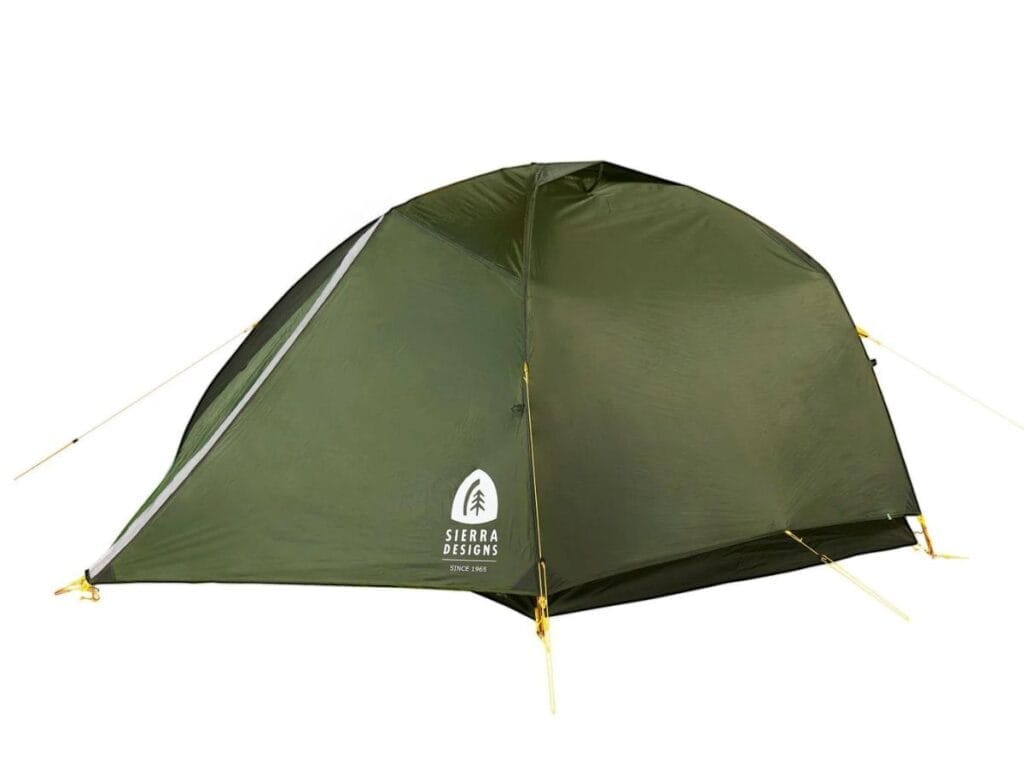
Your primary protection against the elements, a lightweight and durable tent for wild camping is vital. I highly recommend Sierra Designs Meteor 3000, known for its ease of setup and incredible space-to-weight ratio, it’s the perfect choice for a night in the Lake District. Alternatively, spend a night beneath the stars in a bivvy bag.
Sleeping Bag

Depending on the season, choose a sleeping bag that provides adequate warmth. The Mountain Equipment Helium 400 is a favourite among campers; it’s like a cocoon amidst nature, ensuring you’re snug even as temperatures drop.
Sleeping Mat
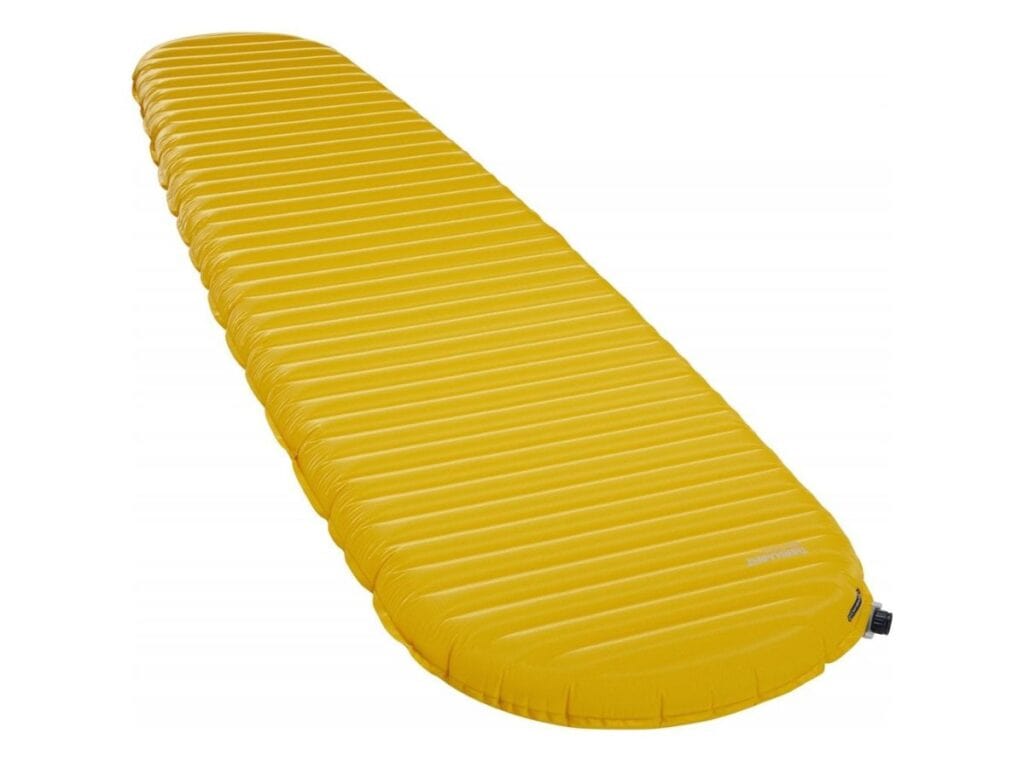
Just as crucial as your sleeping bag, a quality mat like the Therm-a-Rest NeoAir XLite provides a buffer between you and the ground, ensuring a comfortable sleep while effectively preserving body heat.
Camping Stove
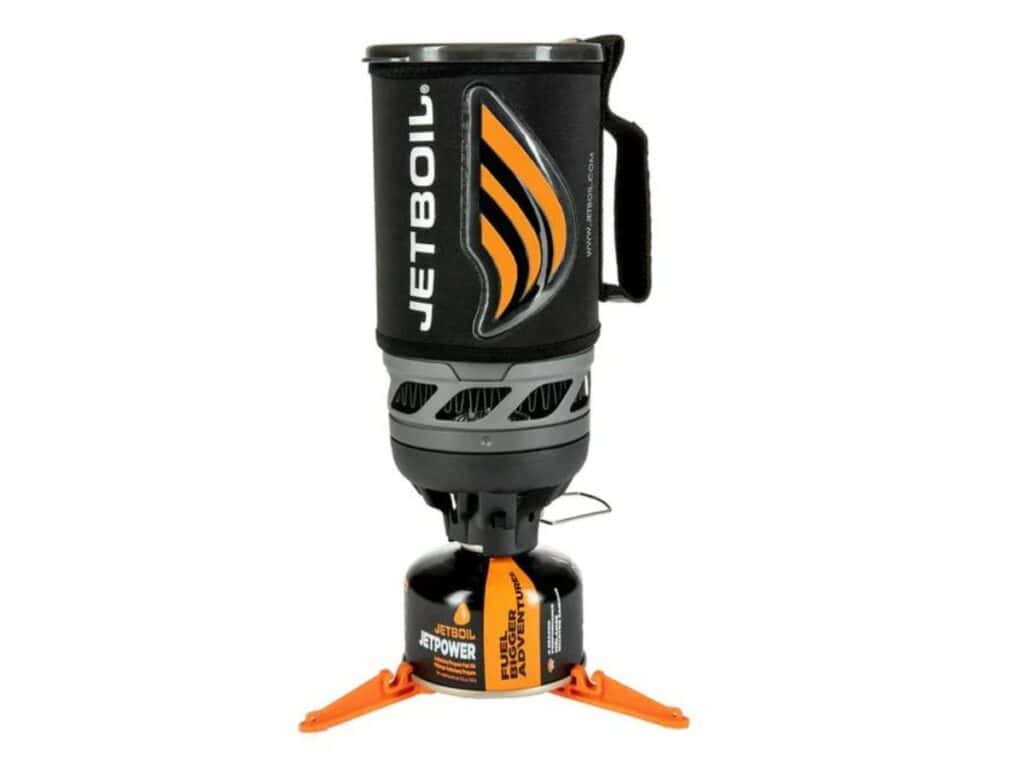
When venturing into the great outdoors, a reliable stove is crucial for preparing warm meals and beverages. The Jetboil Flash Cooking System is a top pick among campers. Known for its rapid boil time and compact design, it ensures you have a hot meal ready in minutes, keeping your energy levels up during your wild camping escapades.
Curious about what else to pack? Dive into my detailed guide on the best wild camping equipment where I share all the essentials required for the ultimate wild camping experience.

About the Author
Steve Cleverdon is an outdoor adventure specialist with 15+ years of hiking, camping, and paddle boarding experience. He has conquered Europe’s toughest trails including the GR20 in Corsica, walked 3,000km solo across New Zealand, and worked professionally in the outdoors industry. Steve’s gear reviews and recommendations are based on real-world testing across four continents, from coastal waters to mountain peaks. Learn more about Steve or get in touch.